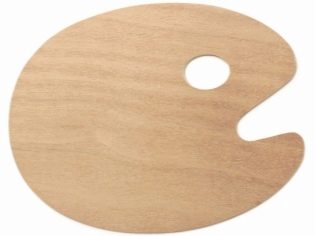How to choose a palette for drawing?
The drawing palette is considered an essential attribute of the artist. Without it, the possibilities are greatly reduced, we have to limit ourselves exclusively to those shades that are in the set of colors. Although the role of such a device seems predominantly auxiliary, professionals choose a palette with a balanced approach. However, professionals know how to do it, but for a child who is only learning to draw, parents should make such a choice: we understand together.
What is it and why?
The art palette is a special square or conventionally oval plank used for mixing colors. In addition to the surface for mixing, it is often completed with a special hole for the thumb. The purpose of the palette is obvious - It helps to convey the fullness of the shades of the world. The one who once held a set of colors in his hands noticed that there were not so many colors there. If you type, say, 24, then the kit can already be considered large.
However, real life is much more multifaceted. The transfer of wealth of shades becomes possible precisely because the individual colors from the set can be mixed in different proportions to get new ones. On paper, professional artists do not do this: you can spoil a drawing with an incorrectly chosen proportion. The palette is a field for preliminary experiments on the selection of tone.
In order to clearly understand why it is needed, take any masterpiece of painting and compare it with a typical children's drawing.
The opening has not only practical, but also a specific artistic role. Besides the fact that it is more convenient to hold the tool in hand, due to the presence of the slot, you can inspect the picture through it with the aim of the most successful selection of the desired shade. Estimated options are applied to the surface of the palette around the slot. So the artist compares how seen in the hole is combined with what is applied at its edges.
Materials
Choose a palette better, starting from the material from which it is made. Theoretically, for this purpose, absolutely any material that does not absorb paint can serve, although some palettes, nevertheless, absorb it. If we talk about the most common options, there are three of them.
Wood
This is a classic, proven over the centuries. Masters that paint with oil paints usually use wood. The wooden palette is good convenience and durability, but requires careful priming with oil in several layers (each after the previous one is completely dry), otherwise it will draw oil from paints. For a palette of wood, high humidity is harmful. Storage in an upright position is fraught with deformation, but it is easy to clean, and therefore it is justly considered a win-win and relevant option worth buying.
Plastic
Modern, lightweight and inexpensive material that does not require priming, is not afraid of water. Dry paint on the plastic surface can be diluted with water and reused. However, not everything is so smooth: when drawing in nature, such a lightweight tool can easily carry the wind away. Keep the product away from sunlight. (they deform the palette).
In addition, watercolor is able to eats into the surface, then wash the palette does not work, which will complicate the correct perception of color.
Paper
Today they also produce paper palettes, which are a notebook of water-repellent paper sheets for 40 (each of them is a disposable palette).This product looks original, but is expensive, it should be stored where the humidity is minimal, otherwise the sheets will go in waves. Some try to use plain paper for this purpose.
It is not cheaper because of its high consumption, as paints are spent faster and brushes wear out, there is a great risk of dirt and pellets formation. At hit in paint glue from cheap paper spoils drawing.
For information on how to properly arrange colors on the palette, see the following video.




























